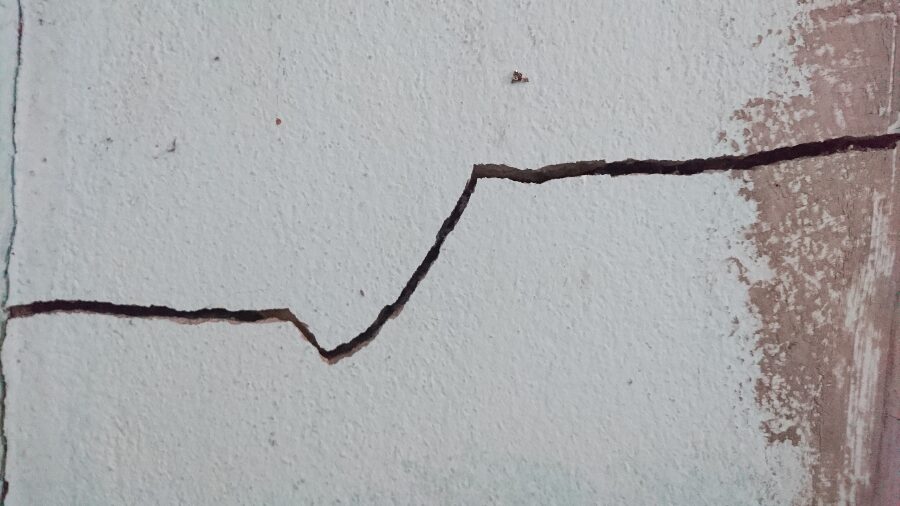Soil subsidence represents a process through which the soil sinks gradually underneath a home, pulling the foundation down with it. Typically, this phenomenon occurs when the soil dries out and shrinks due to prolonged dry spells or due to the presence of large trees or shrubs that absorb a lot of water from the soil around the foundation.
While reduced water content in the soil is the leading cause of subsidence, there are many other natural and man-made factors that could lead to land subsidence.
Natural factors:
- Repeated soil expansion and contraction – One characteristic of clay soils is that they swell and shrink according to the changes in their moisture content. The movement resulting from the repeated expansion and contraction could cause the ground underneath your home to sink in some areas, which may create a number of voids right under the foundation. Consequently, sections of your foundation could settle at different rates and even collapse into those voids, which may cause extensive damage to the structure.
- Soil decomposition/erosion – The ground underneath your foundation is composed of different layers of soil, which include varying amounts of organic and inorganic matter. Depending on their composition, some soil layers may decompose and start to erode when exposed to water. This may cause ground movement and subsidence.
- Tree roots – When certain tree species, such as willow, ash, elm, and oak, are planted near a Houston home, they can absorb a lot of moisture from the ground under the foundation. This could dry out the soil, causing it to shrink, which may lead to subsidence. The same thing could happen when too much vegetation is allowed to grow too close to the foundation.
- Earthquakes – Earthquakes are associated with various hazards, including surface faulting, tectonic uplift, and soil subsidence (rare in Houston, but could happen).
Man-made factors:
- Damaged gutters, drains, water pipes, and sewer lines – The water escaping from damaged gutters, drains, water pipes, and sewer lines can soften and even wash away some of the soil around and under your foundation. A foundation that’s left without the support it needs to withstand the loads on top may crack, sink, and even collapse into the newly formed voids.
- Improper ground preparation when building a home – Without proper soil compaction and grading, the ground or backfill underneath the foundation may be affected by subsidence. As well, incomplete or improper foundation work could lead to subsidence problems down the line.
- Nearby traffic and/or construction work – The vibration and soil disturbance resulting from heavy traffic and/or construction-related activities, such as land clearing and excavation, could cause the ground below your home to move and sink.
How Big of an Issue Is Soil Subsidence?
In Houston and other areas where the clay soil shifts constantly, the long-term effects of subsidence can be devastating for a home. Although land subsidence may start with slight foundation movement and just a few cracks, it could cause a variety of problems that will likely progress into more extensive damage. But that’s not all! The adverse weather conditions that are expected to become more frequent in the future may drive an increase in this phenomenon.
Thus, if you’re considering a house purchase in the Houston-Galveston area, make sure that you require a geological survey that will reveal whether the property is at risk of being affected by land subsidence in the future.
If you already own a piece of property in this area, vigilance is the best defense. The earlier you notice the first signs of subsidence, the easier and less expensive it is to rectify the problem. Here are the most common signs that you may see if your home has been affected by soil subsidence:
- cracks in the foundation, walls, driveways, and/or paths;
- sinking, sloping, or bouncy floors;
- doors and windows that have become misaligned or jammed;
- puddles around the foundation;
- skirting boards or furniture separating from walls.
Also, subsidence isn’t usually covered by homeowner’s insurance policies. Although you might qualify for one of the financing options available for foundation repairs, knowing that you’re going to pay out of your own pocket should give you enough reason to keep an eye out for foundation problems in order to catch them early and prevent severe damage and increased costs.
Solutions to Soil Subsidence
Due to the expansion and contraction effect from very wet conditions alternating with extremely dry conditions, a foundation built on clay soil can witness changes from season-to-season and even from month-to-month. One way to prevent or at least reduce those changes is to maintain a constant moisture content in the ground around your foundation.
If subsidence has already occurred in your home, you should seek immediate help from an experienced foundation repair contractor, like Allied Foundation. Although we typically use concrete piers to lift the home back, correct failures, and prevent foundation problems from reoccurring in the future, the foundation repair method that we recommend will depend on the type and severity of the damage. So, if you’ve noticed any signs of foundation failure, make sure that you call our experts at (281) 238-5010 as soon as possible!

